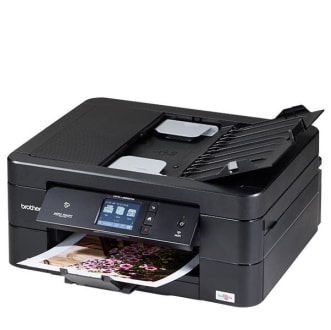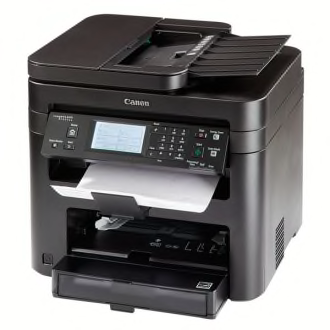
Printer Buying Guide

Senior Home & Tech Writer
We’ll tell it to you straight. It’s hard to find a great printer. Why? Because the kind most consumers buy—the inkjet—is not an electronic device so much as a complex piece of machinery. Peek under the cover and you’ll find an array of motors, pulleys, and gears that move the printheads and feed the paper. In short, there’s more to go wrong, especially because many inkjet printers appear to be designed to deliver the lowest possible selling price instead of long-term reliability.
But that’s just half the story. Once you get that super-cheap inkjet home, you invariably find that it’s not such a great bargain. According to our research, the money you save up front is often offset several times over by mounting ink costs during the first few years of ownership. (More about that below.)
The hidden costs coupled with the reliability problems are why many inkjet models earn low owner satisfaction ratings in Consumer Reports’ surveys—and why we rarely recommend such models.
But don’t worry. There are solid alternatives—laser printers and tank-style inkjets—and our testing has confirmed their attributes. Still, with so many models to choose from, finding the right printer isn’t easy. We’ve assembled a roundup of the best printers for many needs. But before diving in, it makes sense to understand your choices and how to navigate them.
Here’s what to consider before you buy your next printer.
Inkjet or Laser?
All of the printers in our ratings fall into two broad categories: inkjet and laser. The ideal choice for you depends on your budget, the kinds of documents you need to print, and how often you need to print them. Here are the relative strengths and weaknesses of each kind of printer.

Inkjet Printers
If you don’t print a lot and it’s typically a combination of text, graphics, and photos—especially in color—you can make do with a cheap inkjet printer. Just be aware of the drawbacks.
While traditional inkjets can be cheap to purchase, the cost of ownership can quickly expand, because of those wildly expensive ink cartridges. What’s more, a lot of that ink never ends up on the page—instead it gets slurped up in the routine maintenance cycles needed to keep your printheads unclogged.
A low-priced inkjet can saddle you with cartridge replacement costs of $70 a year or more. By comparison, the toner for a black-and-white laser printer might set you back just $15 a year. Another money-saving option, especially if you often print in color, is an inkjet tank printer, which requires a little more spending up front but typically lowers your ink costs to less than $10 annually.
And to top it all off, estimated brand reliability and owner satisfaction ratings—based on CR’s member surveys—tend to be lower for inkjet printers than laser printers.

Laser Printers
If you primarily print text documents—and a lot of them—a laser printer makes a lot of sense.
Monochrome laser printers produce razor-sharp black-and-white text, which is what most consumers use their printers for. And they do it fast and inexpensively.
Typical toner costs for a black-and-white laser printer are about $15 a year, while the costs to run an inkjet can be five times as much. Laser printers also tend to outperform inkjets in terms of speed, cranking out black-and-white text at a rate of nine to 25 pages per minute. Another advantage: According to data from our member surveys, laser printers, which are somewhat less complicated mechanically than inkjets, tend to be more reliable than their more popular cousins. That’s one reason why user satisfaction is generally high among laser printer buyers.
Most laser printers aren’t great at printing graphics or photos, although some of the more expensive models do a better job at this task. And color laser printers are quite expensive to buy and maintain.
Here’s a list of the best laser printers among the 200 models in our ratings.
Tank Printers to the Rescue
The good news? Some inkjet printers can drastically cut your ink costs. Better known as tank printers, they dispense with the pricey replacement cartridges in conventional inkjets in favor of reservoirs that you refill with bottled ink. In recent years, tank printers have gotten easier to fill and better at printing than their early counterparts, which makes them a realistic alternative for anyone who wants to print in color and save money while doing so.
Tank models do cost more up front, often selling for $250 or more, but they save you money over time. With ink costs of $10 per year, the five-year cost of ownership stretches to, say, $300. If you buy a conventional inkjet printer for $100 and pay $70 a year for ink, you’re looking more at $450.
Canon and Epson tank printers earn favorable owner satisfaction scores in Consumer Reports’ surveys. However, we currently do not recommend any Canon MegaTank printers because the brand has received a less-than-favorable rating for predicted reliability.
Here’s a rundown of the best tank printers on the market right now.
More Than Just Printing
In our ratings, we separate models that just print from those that perform functions like faxing and scanning, too. Here’s more about these two categories.
Regular
If you don’t need to scan, copy, or fax—or you have easy access to machines that do those tasks—you can save money with a regular (or basic) printer. Those have just one function: to print. Models start at under $100, but remember that the cheapest options are inkjets, which can add long-term ink costs.
All-in-One
A printer with scanning, copying, and faxing capabilities doesn’t cost a whole lot more. It doesn’t take up much extra space either. In many cases, it can also be less expensive and more space efficient than buying separate devices to perform these tasks.
However, if you’re doing more than just making an occasional copy or scanning a random paper document to attach to an email, remember that all-in-one printers generally have fewer features than stand-alone scanners, copiers, and fax machines.
And speaking of scanning, look for a printer model with a flatbed design instead of one that scans through the paper feed. This will allow you to copy not only paper documents but also book pages and photos with ease. Some all-in-one printers also have built-in duplexers to automatically print on both sides of the page, which saves on paper costs and cuts down on waste.
Think About Ink Costs
While we’ve talked about ink and toner costs in general terms, our ratings deliver specific information. To get a sense of how different models consume this precious ink, check out the test scores for maintenance ink use in our printer ratings, available to CR members.
In those ratings charts, we also provide the estimated cost per year for ink or toner, as well as the cost to print a page of black text. To arrive at those numbers, we use the price of replacement cartridges, ink, or toner; data from our member surveys on how much consumers print; and measurements of ink consumption from our labs.
Buying Guide Video
For more, watch our video below.



























